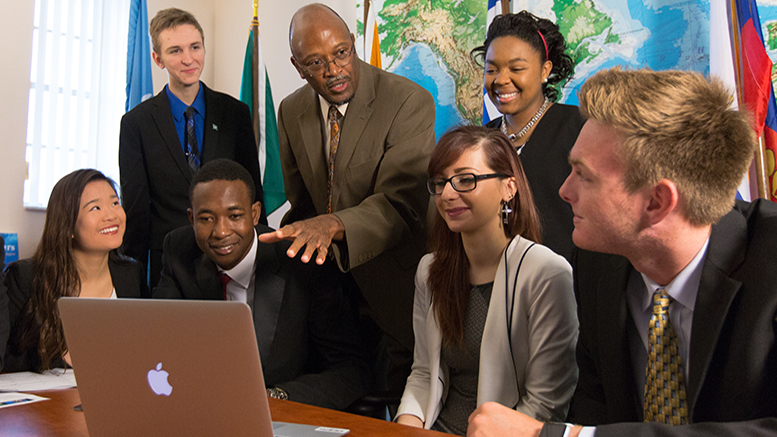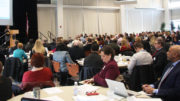Because pathways call for streamlined curricula that might lead to the elimination of some courses, however, college leaders can overcome faculty resistance by bringing faculty into the decision-making process on course mapping and curriculum design.
“The implementation of a large transformative reform effort, like pathways, means it’s absolutely essential for faculty not only to be engaged but to play a leadership role,” says Gretchen Schmidt, executive director of the Pathways Project at the American Association of Community Colleges (AACC).
AACC has instituted two initiatives to help colleges support faculty leadership:
- A new Faculty Council was created last winter to advise AACC on how faculty can be involved in pathways and other initiatives.
- The 2017 AACC Annual Convention will for the first time have a faculty track, aimed at providing professional development to faculty who seek greater involvement in pathways and other reforms – and to promote collaboration and networking with their peers.
Calming anxieties
At St. Petersburg College (SPC) in Florida, which is one of 30 community colleges selected for AACC’s Pathways Project, faculty have been deeply involved in aligning all the academic programs into 10 broad pathways, such as healthcare and business.
Each pathway has its own sequence of courses, student services, and specific milestones (such as a capstone project or internship), says Margaret Bowman, director of curriculum services. By April 2017, the college hopes to have all pathways in place in time for fall registration.
When the college started working on career pathways in 2014, Bowman says, faculty looked at every course in a particular program. For the associate degree program in business, for example, faculty listed on sticky notes every course and every prerequisite. They discussed the best way to start the program, the general competencies students need early on, how to build on those competencies and how to introduce core concepts in business administration.
Faculty then arranged their notes to come up with a list of 20 courses in sequential order.
“That was the first baseline snapshot of a pathway,” Bowman says.
After much collaborative work with faculty, she says, “they’re at the point that whenever they make a curriculum change, the first questions are, ‘What is this going to do to the pathway?’ and ‘What is it going to do to the student experience as they go through the program?’”
The decision about which electives to recommend was based on which courses would best prepare students for entry into the workforce, Bowman says.
“In the past, we told students, ‘Pick your options.’ Now, with pathways, we’re saying if you’re going for an accounting degree, these are the four recommended electives,” although students aren’t limited to those four.
Early involvement
Faculty at Jackson College in Michigan were involved in the development of pathways from the start, says Provost Rebekah Woods.
While the college is in the AACC Pathways initiative, it had already created six pathways as part of an earlier effort spearheaded by the Michigan Community College Association.
“The essential nature of pathways necessitates the early involvement of faculty in terms of their consideration of, as well as their leadership, in mapping, implementation and evaluation of this vital work,” says Jackson College President Daniel Phelan, who also chairs the AACC board of directors.
“The active engagement of faculty helps to ensure that the pathways model is hardwired into the entirety of the educational experience for students, as opposed to being perceived as the next ‘initiative’ with limited sustainable staying power,” Phelan says.
Leadership teams
A success council, made up of faculty and administrators from every department at Jackson started having conversations about pathways about three years ago, and that led to the creation of a steering team charged with implementing pathways with embedded student support services, says Woods, who co-chairs the team.
The steering team developed an action plan and timetable and created a leadership team for each pathway aligned to academic departments.
“We want to make sure faculty are the champions; they are the face of this work,” she says. To get faculty buy-in, “they have to believe this is something we need to do to help our students be successful.”
The main hesitation among faculty came from those in the arts and sciences who feared their classes might not get selected for a pathway – possibly leading to the loss of their jobs.
“We made it clear to them that while we might not offer all classes every semester, no one would be laid off and no one would lose a class,” Woods says.
There were also concerns from the faculty that “we were forcing students at a young age to make decisions in their first semester that would determine the course of their life without giving them enough tools to make an intelligent choice.”
To address that concern, students now take a first-year seminar aligned with their chosen pathway. The course covers the job outlook, projected salaries and an opportunity “to connect with faculty and employers to get a sense of what it would be like to work in that pathway and decide if that is the best fit for you,” Woods says.
Career communities
Faculty at Sinclair College in Ohio have been active in developing academic pathways since 2012 as part of the Completion by Design initiative.
Each pathway has embedded advisors and serves as a template for recommendations on how individual maps should be created for each student, with a sequence of courses and electives, says Mary Wells, an associate psychology professor who is heading the academic part of the pathways effort.
A steering committee, comprising faculty and advisors, is assigned to each of the college’s five career communities – liberal arts and social science, creative studies, STEM, business and public safety, and healthcare – and each one is divided into narrower pathways.
The goal is to ensure students don’t take the wrong courses – and end up with credits that won’t transfer or earn more credits than they need.
“There are lots of choices, and that means there are lots of opportunities to make poor decisions,” Wells says. “The map is a way to provide guidance and make sure students know what to do.”
Wells and her colleagues are now working on an “undecided pathway” so students who don’t know what career they want to pursue can spend a term or two exploring options. If they’re interested in the broad field of healthcare, for example, they spend that time exploring options, which helps them decide on nursing, respiratory care or some other health-related occupation.
Since piloting the pathways approach five years ago, graduation rates increased about 80 percent, she says, and the average number of credit hours earned decreased an average of 15.6 per graduate.
Removing barriers
At Skagit Valley College (SVC) in Washington, which is in the AACC Pathways Project, faculty and department chairs have developed a set of meta-majors and are working on course outcomes, curricula and course sequencing.
A group of faculty members are looking at the college’s implementation of a pathways model “as a way to create a more equitable institution,” says Gretchen Robertson, a basic skills instructor and facilitator of a faculty group on inclusive learning pedagogy.
The work on pathways includes a strong focus on the need to recognize how the college is unwittingly putting up barriers that discourage students from succeeding, Robertson says. Much of that comes from a lack of transparency in what faculty expects from students.
Adopting a pathways approach won’t work if it merely changes the structure of the college without changing what happens in class, she says.
“We expect students to come into courses with a understanding of cultural norms,” Robertson says. If students don’t come from an academic background, they need to have faculty spell out for them exactly what they need to do to succeed in class and how they will be graded.
While removing unintentional barriers, “we’re still engaged in rigor, inquiry and critical literacy. Those are important,” she says. “We wanted to break down those silos, to be intentional about creating a dynamic and full experience for students.”
Inclusive pedagogy
Robertson started a faculty learning community last winter on the “inclusive pedagogy” concept. “We’re really intentional about making that central to the pathways work,” she says.
Five faculty members who had been in that group then started implementing experimental strategies in class. In one example, a nursing instructor introduced a “growth mindset” based on research about how students’ attitudes toward learning and intelligence can promote or inhibit their capacity for success.
If students see intelligence as something fixed that they’re born with – that they’re either intelligent or not – that inhibits their motivation to succeed in college, Robertson says. If, on the other hand, students are told “you can grow your intelligence,” that promotes learning and encourages students “to dig in and do the work.”
When faculty are concerned about the prospect of losing a course they’ve taught for years on a subject they’re passionate about, Robertson says, “we need to honor that sense of loss,” while at the time, “look for opportunities to be intentional in research and design.”
“What we’re hoping for with our instructors is that they can start to see themselves as experts in multiple domains – in organizational development, as well their specific subject,” Robertson says.
“We want faculty to change their attitudes,” she says, “to think about how pathways will not just impact my class, but how it will impact the institution as a whole; to think about ‘our students and our courses,’ not ‘my students and my courses.’”



